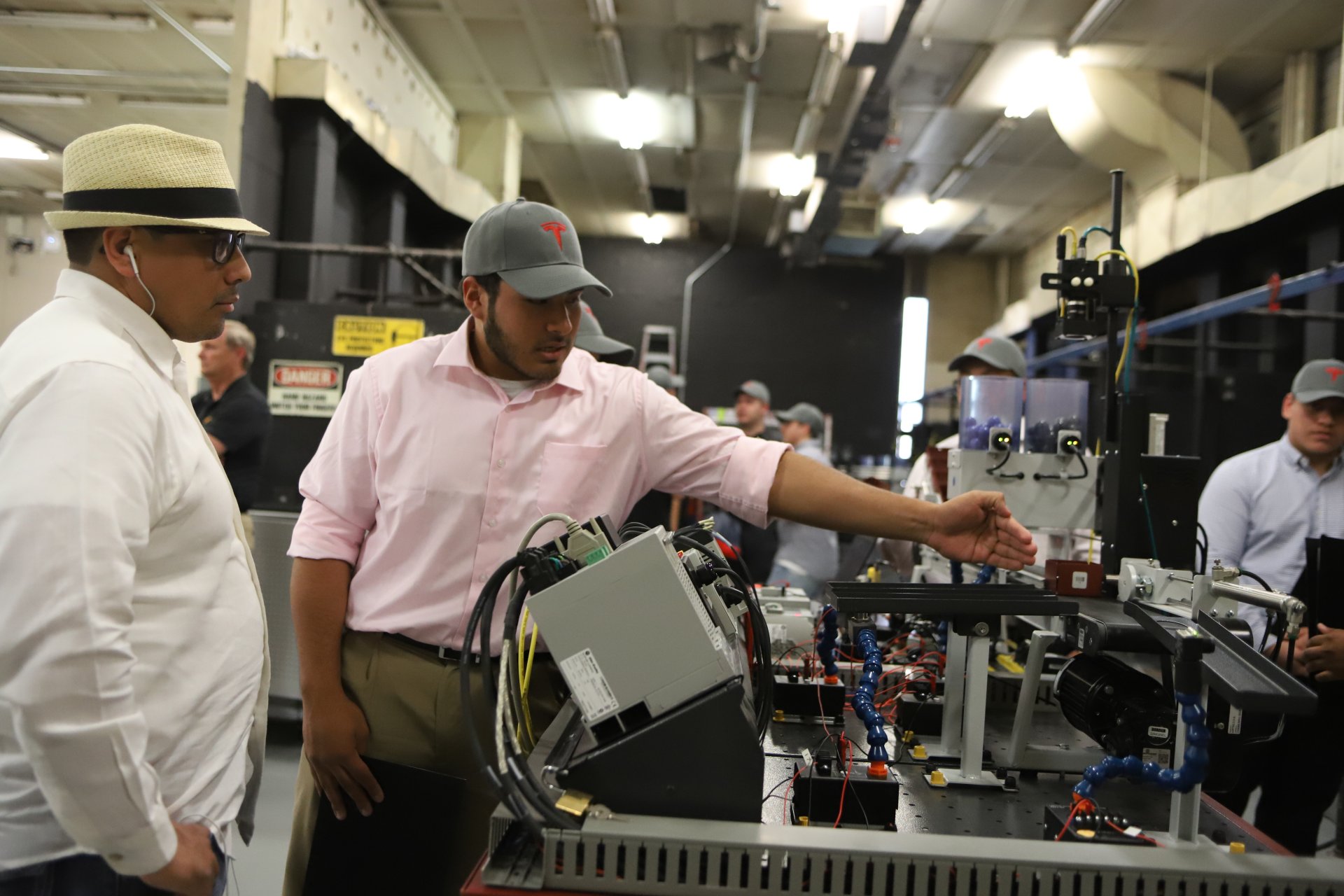4:30
News Story
What the bond between public education and private labor looks like
Two days before Southeast Career Technical Academy held its graduation ceremony at Orleans Arena, a much smaller celebration took place in a rec room on the school’s eastside campus. There were inspiring speeches, cupcakes, proud parents… and a $70k electric car.
It was a celebration for approximately two dozen students from SECTA, Desert Rose High School and Mojave High School who have been hired by Tesla to work in its Northern Nevada lithium ion battery plant, known as Gigafactory 1. As part of the company’s Manufacturing Development Program, the cohort is scheduled to begin working full-time as production associates next month. They’ll be living together in dorm-style apartments and receiving scholarships to Truckee Meadows Community College where they can further their education.
For at least one student, it will be their first job ever.
A Tesla representative at the event declined to give a pay range for their production associates, saying only that the company pays competitively. One student told the Current he’d be making $16 an hour – almost twice the state minimum wage of $8.25 an hour.
To get to this point, the high school students took numerous courses in the advanced manufacturing program at the career and technical magnet school, which is part of Clark County School District. While the district as a whole is largely and publicly panned as being low performing, magnet programs like those offered at SECTA have been an exception to the rule. They’ve received national recognition and acclaim.
“Public education at its best” is how CCSD Career and Technical Education Director Kerry Pope described the partnership and the unprecedented opportunity it’s created for the students.
It may also be a sign of the future, as ties between public educational institutions, private businesses and public economic development centers become increasingly intermingled at both the local and national level. Underscoring the trend, last week, the Trump administration proposed a merger of the departments of education and labor.
Nevada wooed Tesla with $1.3 billion worth of incentives back in 2014. As part of that deal, the company agreed to hire half of its workforce from within the state. That means the company needs locals with the right robotics and automated machinery skills, which has led to calls for stronger workforce development pipelines.
In 2016, Gov. Brian Sandoval created the Governor’s Office of Workforce Innovation for a New Nevada (OWINN) to help strengthen those pipelines. Among its goals: increase the number of apprenticeships and workforce training programs. Earlier this year, the office announced a program and partnership between Truckee Meadows Community College and Panasonic, which also employees people at the Gigafactory. The latter has promised to hire 500 apprentices. Northern Nevada’s largest healthcare company, Renown Health is also involved.
Clarissa Cota, the interim vice president of academic affairs at the College of Southern Nevada, says aligning educational offerings with workforce development needs is crucial but costly. Financing for programs is often piecemealed from different financial sources, including OWINN, the Nevada Department of Employment, Training & Rehabilitation (DETR), the Nevada Department of Education and federal grant money.
One piece of robotics equipment used by the Tesla-bound students at SECTA cost $40k. Another was $80k. Both were made available to SECTA through a partnership with CSN, which owns them for use in their own automated technology programs.
“We’d love to see employers much more engaged in not only the development side but also the educational investment in programming,” says Cota. “It’s a collective effort.”
Educational institutions like CSN find themselves in a balancing act. They want to talk to the employers and prospective employers about how they can help meet workforce needs, but they cannot become so accommodating as to replace a company’s inhouse training program.
Consider Faraday Future, the failed project that was supposed to bring $1 million in investments and a manufacturing plant to Apex Industrial Park in North Las Vegas.
“A couple years go we’d align with training for Faraday,” says Cota. “We thought ‘this large-scale employer is coming so we needed this kind of training.’ What we had to do was take a look and make it a more general training – to something that’s for more than just one particular employer. That’s an important lesson to learn.”
Cota says it was easy enough with the equipment purchased with Faraday in mind because it was versatile.
“Tesla, Panasonic and other companies are impressed by the equipment and the hands-on training it provides,” she says. “That industry, while it may not be identical, there is some uniformity.”
CSN will soon begin working on a four-year master plan that identifies programs that should be expanded to meet student and business demand. During the planning process, administrators will work with economic groups, chambers and the rest of the business community.
Meanwhile, Federico Zaragoza is set to begin as the college’s next president on August 15. Zaragoza’s last job? Vice chancellor for economic and workforce development at the Alamo Colleges in Texas.
Our stories may be republished online or in print under Creative Commons license CC BY-NC-ND 4.0. We ask that you edit only for style or to shorten, provide proper attribution and link to our website. AP and Getty images may not be republished. Please see our republishing guidelines for use of any other photos and graphics.




